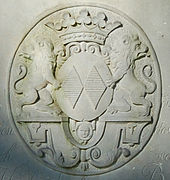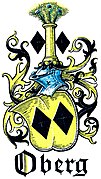Oberg (noble family)
The lords and counts of Oberg belonged to the Hildesheim and Altmark nobility . Extinguished in 1861 in the male line of the Count, there are still branches of the family today.
history
Bishop Adelog von Hildesheim granted parish rights to the chapel in Oberg in 1189, for which he removed the chapel, which was on the property of Heinrich the Lion , from the parish with its mother church in Münstedt with the consent of the archdeacon of Schmedenstedt . Here were Johannes de Oberge with his sons Eilardus and John and Bernard of Oberg and his son Theodoric witnesses and the family joined by first documented appearance. The Lords of Oberg received patronage over the chapel as a fiefdom of the Guelphs . The uninterrupted line of trunks begins with Johann von Oberg, who appears in a document on Woldenberg in 1329. Later they also received fiefs from the Diocese of Hildesheim and from Gandersheim Monastery , mainly in the area of the Hildesheim Monastery .
According to current sources, it is uncertain whether the famous author of the Tristant , Eilhart von Oberg , comes from the same sex.
Hildesheim Monastery
In the 13th century, the Lords of Oberg were temporarily bailiffs to the castles Schaumburg (the Counts of Schaumburg ) and the Guelph castles Lauenrode (in Hanover) and Lüneburg . In 1278 they sold their Hude Castle to Hildesheim Bishop Otto I , which historical research could not locate, so that a predecessor of Ruthe Castle is assumed. In 1306 their castle Oberg was destroyed in a feud. Therefore, the gentlemen turned to pawns. In 1311 they acquired Lutter Castle as a pledge, then Neuwallmoden Castle . In the 14th century they also took on services for the Halberstadt diocese .
The Lords of Oberg were partisans of Otto des Quaden when the Battle of Dinklar took place in 1367 . In the following year, the battle winner, Bishop Gerhard, and the son of the main opponent, Magnus II and Wilhelm II, formed an alliance. The alliance of territorial princes was directed on the one hand against the rising lower nobility. On the other hand, Bishop Gerhard aimed at Otto the Quaden, because the Principality of Göttingen bordered the County of Dassel, which became a bishopric in 1310 . In this regard, the alliance was favored by the looming War of the Lüneburg Succession . Soon the allies attacked Neuwallmoden Castle with the support of regional citizens, but it withstood the siege for around four weeks. When Bishop Gerhard then had the Neile dammed, its fortification came under water and it was lost to the Lords of Oberg. As a result, they lost their possessions in the northern foreland of the Harz , although they were still trying to build the castles Dahlum and Brunstein , and had to retreat to the area around Oberg. The line there died out in 1861 (see below).
Benedikt (Bendix) Wilhelm von Oberg was appointed heir to the Jersbek estate in Storman (Schleswig-Holstein) by his uncle Adolf Jasper von Ahlefeldt in 1756 ; the large, but already indebted property was completely ruined by Bendix Wilhelm, so that he had to sell the Jersbek and Stegen estates in 1774.
Branch Oebisfelde
At the time when the Hildesheim monastery was able to consolidate its rule in Peine , a second line of Oberger had formed. This came into the possession of the lordship, castle and city of Oebisfelde in 1289 and in 1369 gave the archbishopric of Magdeburg Oebisfelde as a fief to protect against hostile neighbors . In the land book of Karl IV. From 1373, the Lords of Oberge are among the people of the Altmark who were seated in the castle . The Oberg-Oebisfeld branch went out in 1448 with Günther von Oberg, who had previously ensured market rights and the recognition of the city's coat of arms. Oebisfelde then came first to a line from Steinberg , and later to other gentlemen such as von Bülow .
Representative

- Eilhart von Oberg , poet (mentioned 1189 to 1227, suspected connection)
- Johann (Jan) von Oberg fought for the Bishop of Hildesheim against Magdeburg in 1435
- Wulbrand († 1523), Provost of Osnabrück (Jan's grandson)
- Margarethe von Oberg, daughter of Hilmar von Oberg and Ilse von Steinberg , married Stacius von Münchhausen before 1500 , her son was the well-known mercenary leader Hilmar von Münchhausen
- Burchard von Oberg († 1573), Prince-Bishop of Hildesheim (1557 to 1573)
-
Georg Wilhelm Ludwig von Oberg (1711–1762), 1737 co-founder of the first Masonic Lodge and first Master of the Chair in Germany, father of
- Metta von Oberg from Jersbeck (1737–1794), canoness
- Adolph Ludwig von Oberg, major in the Danish service
- Benedikt Wilhelm Georg von Oberg (1747–1819)
- Jobst Aschwin von Oberg, Braunschweig colonel in 1690
- Sigismund Julius von Oberg (brother of Jobst Aschwin) had the sons Hermann Otto, Christoph Ludwig, Ernst Wilhelm and Hilmar
Last of the sex

The sex is extinct with Hilmar Ludwig Wilhelm Graf von Oberg (* April 25, 1776, † October 26, 1861) in the male line. He and his brother Benedikt Wilhelm Georg († 1819) were raised to the Prussian count on July 10, 1803.
The older brother Hilmar, gentleman on Oberg , Schwicheldt , Stederdorf , Drakenburg and Duttenstedt , married Sophie Christine Charlotte von dem Bussche-Lohe (1782–1817) from nearby Rethmar , daughter of Friedrich August vdB-L , in his first marriage in 1800 . to Lohe, Fulde, Sudkampen, Buschhausen and Schloss Rethmar , vice- chief stableman in London, and Louise von Steinberg . His second marriage was in 1832 with Sophie von Praun (1784–1863), daughter of Carl von Praun and Caroline Christine von Lasperg, widow of Ludwig von Münchhausen (1758–1827) in Hessisch Oldendorf , Groß Vahlberg and Haynspitz. From his first marriage he had four daughters:
- Ida (* 1804 + 1845) ⚭ 1831 Carl Eduard von Bose (* 1797 + 1840)
- Bertha (* 1803 + 1876) ⚭ 1823 Hans von Veltheim from the Destedt house (* 1798 + 1868)
- Thekla (* 1804 + 1866) ⚭ 1829 Carl Freiherr Löw von Steinfurth (* 1796 + 1867)
- Anna (* 1814), on Oberg, ⚭ Hermann von Kalm, on Halchter
coat of arms
The coat of arms shows two upright black diamonds in gold . On the helmet with black and gold covers, a golden column decorated with three natural peacock feathers, each accompanied by a black diamond
Coat of arms of the von Oberg family in Siebmacher's book of arms
Otto Hupp's coat of arms in the 1934 Munich calendar
Evocation board
Enlistment board of Hedwig (Helena) von Oberg, married to August Rudolf von Veltheim . She spent her later years in the Clarenberg Monastery (Dortmund-Hörde).
literature
- Detlev Hellfaier: Studies on the history of the lords of Oberg up to the year 1400 . Hildesheim 1979, ISBN 3-7848-3643-7
- Ernst Heinrich Kneschke : New general German nobility lexicon , Volume 6. 1865, p. 551f
- Genealogisches Handbuch des Adels , Adelslexikon Volume IX, Volume 116 of the complete series. CA Starke Verlag , Limburg (Lahn) 1998, pp. 480-481, ISSN 0435-2408
Web links
- Coat of arms of the von Oberg family in Johann Siebmacher's coat of arms book from 1605, plate 179
Individual evidence
- ↑ Orig. Guelf. III 559
- ↑ Coat of arms on seal on certificate
- ↑ Genealogisches Handbuch des Adels, Adelslexikon Volume IX, Volume 116 of the complete series, pp. 480–481






